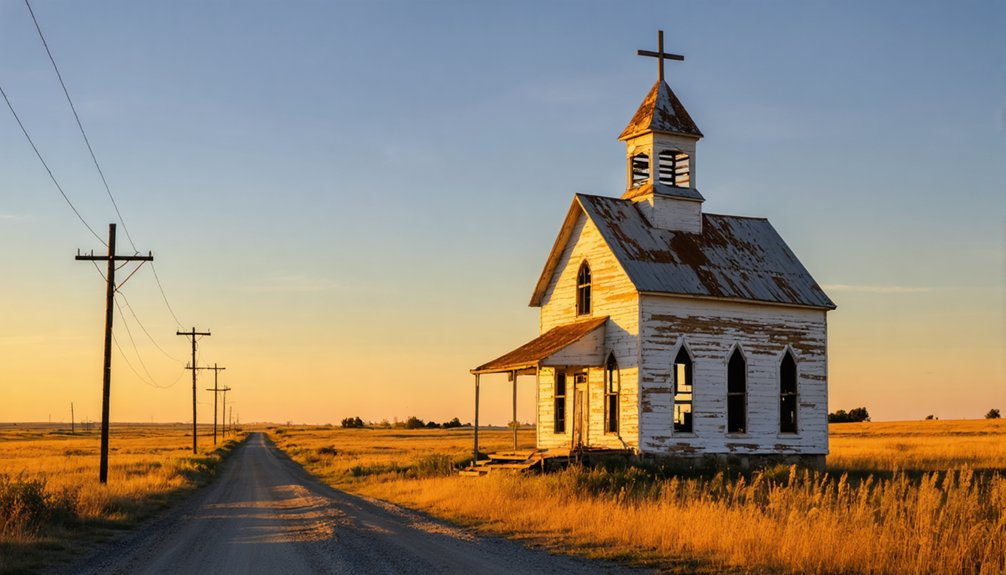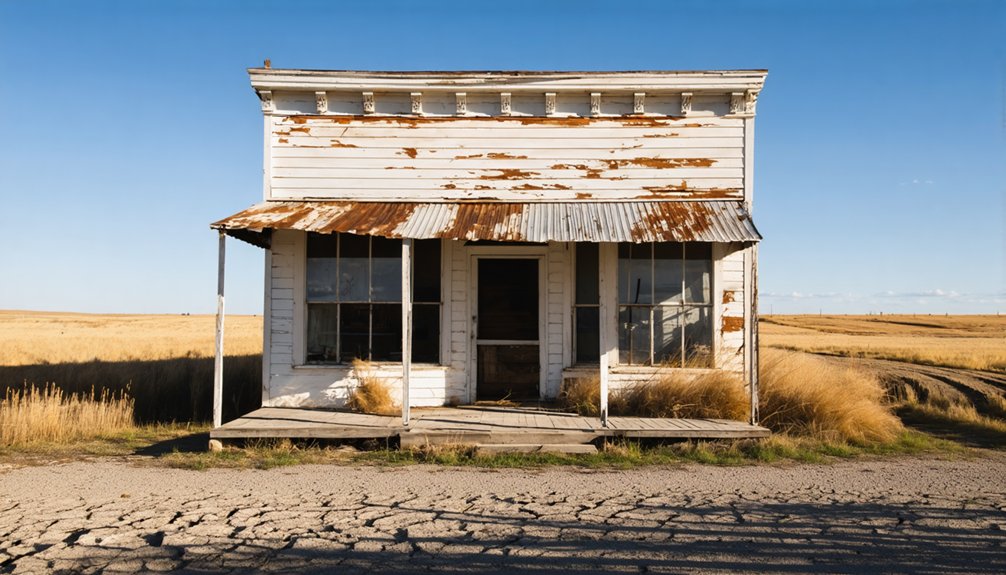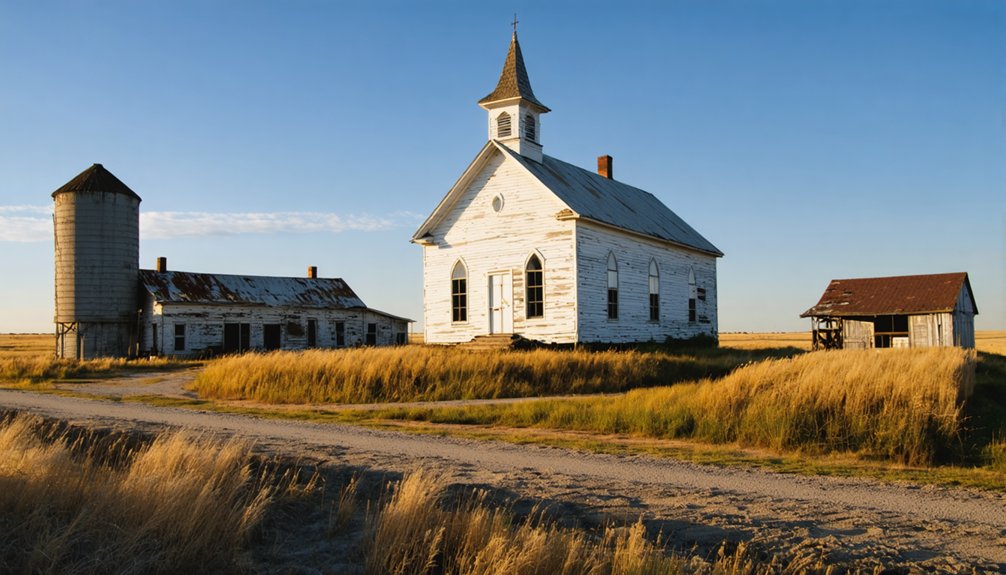You’ll find Argyle, South Dakota as a reflection of frontier boom-and-bust cycles, reaching its peak of 600 residents in 1911. The town thrived on mining operations and agricultural services, complete with grain elevators, hotels, and retail shops. When railroad lines bypassed the area and mining became less profitable, the population dwindled to just 16 by the 1980s. Today, weathered foundations and scattered artifacts tell the story of this once-bustling community.
Key Takeaways
- Argyle, South Dakota peaked at 600 residents in 1911 before declining to just 16 residents by the 1980s.
- The town’s decline was triggered by railroad bypasses, mining unprofitability, and severe drought conditions in the mid-20th century.
- Originally established as a frontier settlement, Argyle thrived on mining, agriculture, and timber industries in the late 19th century.
- The community’s business district once featured hotels, drug stores, and grain elevators before economic hardships led to widespread closures.
- Today, only foundations, weathered buildings, and artifacts remain as evidence of Argyle’s once-vibrant community.
Early Settlement and Origins
As the late 19th century ushered in an era of western expansion, Argyle emerged as one of many frontier settlements in South Dakota’s developing landscape.
Like its neighboring Black Hills communities, you’d find settler motivations centered around access to crucial resources, transportation routes, and promising economic ventures in mining, agriculture, and timber.
Settlers flocked to Black Hills towns seeking natural wealth, from precious metals deep underground to timber-rich forests reaching skyward.
The community dynamics took shape as families established themselves around essential infrastructure, with the town’s development closely tied to the period’s railroad expansion. Similar to towns like Tunnel and Dewey, Argyle’s fate would be influenced by the evolving transportation methods of the region.
While the specific origin of Argyle’s name remains less documented, you’ll recognize a pattern common to frontier towns where naming often reflected the settlers’ heritage or aspirations.
The Homestead Act of 1862 attracted many settlers to the area with the promise of 160 acres of farmland.
The settlement grew large enough to support basic amenities that defined a proper town by frontier standards, including a post office and communal gathering spaces.
Life in Frontier Argyle
Life in frontier Argyle revolved around a tight-knit community where survival depended on mutual support and shared resources.
You’d find residents gathering at the post office, church, and community hall, where social bonds strengthened through shared experiences and celebrations.
Daily routines centered on essential work – men labored in mines or ranches, while women managed households and gardens.
Children split their time between schooling and helping with family duties. Your home would’ve been a simple log cabin or frame house, heated by wood stoves and lit by oil lamps.
Like the town of Awanka, the community once boasted two bustling hotels that served as social hubs for both residents and travelers.
Community gatherings offered rare chances for entertainment through dances and fairs.
The mining operations were lucrative, with ore worth $30 per ton extracted from local mines.
Life wasn’t easy – you’d face limited medical care, harsh winters, and constant economic uncertainty.
As resources dwindled, families gradually left, leaving buildings to decay in their wake.
Economic Rise and Development
You’ll find that Argyle’s early economic success centered on agricultural services, with the town boasting multiple grain elevators, banks, and farm implement dealerships by 1909.
Like many towns in the area that faced the harsh realities of the Dirty Thirties, Argyle’s economic stability gradually eroded.
Similar to the mine closures that devastated communities like Spokane, South Dakota in 1940, Argyle’s economic vitality diminished over time.
The business district thrived with two hotels, a drug store, blacksmith shops, and various retail establishments serving a growing population that peaked at 600 residents in 1911.
Despite promising beginnings, Argyle’s fortunes shifted when railroad lines bypassed the town in favor of nearby communities like Columbia and Ordway, marking the start of its economic decline.
Mining and Railroad Growth
While the discovery of gold near French Creek in 1875 sparked initial interest in the Black Hills, it was the establishment of the Homestake claim in 1876 that transformed Argyle and the surrounding region into a significant mining hub. The fur trade industry had previously dominated the region’s economy in the early 1800s.
You’ll find that mining techniques evolved rapidly from basic placer mining to sophisticated hard rock operations, with George Hearst‘s $70,000 investment in 1877 accelerating this transformation. Modern operations required extensive infrastructure development, including a massive brick headframe that stood nearly 1,550 feet tall.
Railroad innovations proved essential to Argyle’s success, enabling efficient transport of ore and crucial mining supplies.
- Compressed air locomotives replaced animal labor underground by 1901, revolutionizing ore transport
- The innovative cyanidization process improved gold recovery rates to 94%
- Extensive ventilation systems pumped 500,000 cubic feet of fresh air per minute to miners
- Rail lines connected Argyle to critical markets, including the Denver Mint, attracting further investment
Local Business Expansion
Beyond the mining boom and railroad development, Argyle’s economic landscape transformed through strategic business diversification in the early 20th century.
You’ll find that local entrepreneurship shifted from large open-range cattle operations to specialized family and corporate ranches, with many focusing on specific ventures like horse breeding or cattle production.
While dryland farming attempts failed, the community’s business focus on ranching and feed crop specialization provided economic stability.
You can trace the area’s growth through expanded services supporting tourism, particularly due to proximity to Black Hills National Forest and Mount Rushmore.
Infrastructure improvements, including the Southern Black Hills Water System, have strengthened the foundation for business growth.
The region’s economic development strategy embraces public-private partnerships, creating opportunities for investors while preserving the area’s rich heritage through tourism-related enterprises.
The Railroad’s Influence
During the pivotal period of 1878 to 1887, the expansion of railroads transformed South Dakota’s landscape and played a defining role in Argyle’s development.
Like many communities of the era, Argyle’s future hinged on securing a position along critical railroad routes. You’ll find that towns fiercely competed to attract railroad companies, knowing their very survival depended on it. Local business owners and community members, much like those in Dakota City Advance, used newspapers to promote growth and attract railroad interest. The completion of the Transcontinental Railroad in 1869 had already demonstrated how vital rail access was to a town’s prosperity.
The railroad’s presence meant more than just transportation – it was the lifeline that connected remote settlements to essential markets and resources.
- Railroad access determined whether communities would thrive or fade into obscurity
- Towns often relocated entirely to align with chosen rail routes
- Rail lines brought necessary materials while taking local products to market
- Railroad construction created jobs and attracted new settlers to the region
Notable Buildings and Landmarks

As you explore Argyle’s remaining structures today, you’ll find a haunting collection of weathered buildings that tell the story of this once-vibrant prairie town.
The historic architecture consists mainly of single-story wooden structures, including deteriorating residences with simple gabled roofs typical of prairie design.
Simple wooden homes with gabled roofs stand weathered but dignified, embodying the humble spirit of prairie architecture.
You’ll discover traces of key community landmarks that once served local farmers: remnants of grain elevators, the old general store, and a former post office.
While most church buildings have vanished, their foundations still mark where these spiritual centers once stood.
On the town’s outskirts, small cemeteries preserve the names and stories of early settlers through their weathered headstones.
The original town layout remains visible through old streets and lot divisions, while the surrounding prairie slowly reclaims these pioneer-era structures.
The Decline Years
You’ll find that Argyle’s decline followed a familiar pattern as its mining operations became less profitable and businesses started closing their doors in quick succession.
The railroad’s decision to cease services dealt a severe blow to the remaining economic activity, cutting off essential transportation links that had sustained the community.
As employment opportunities vanished, families who’d built their lives in Argyle began moving away, leaving behind empty buildings and quiet streets that would eventually transform the once-bustling town into another Black Hills ghost town.
Economic Activity Fades Away
While the mining industry’s decline struck many South Dakota towns in the early 20th century, Argyle’s economic downfall proved particularly severe.
Without its mining backbone, the town’s economic sustainability crumbled as critical infrastructure deteriorated. You’d have witnessed the community’s resilience tested as transportation links weakened, isolating Argyle from essential trade routes and visitors.
The ripple effects devastated local commerce, forcing businesses to shutter their doors permanently.
- Essential services like schools and banks vanished, pushing more residents to seek opportunities elsewhere
- Rail line removals cut off critical supply chains and trade connections
- Commercial buildings stood empty as customer bases dwindled
- The labor force exodus created an irreversible cycle of economic decline, preventing any meaningful recovery
Population Exodus Begins
During the 1960s and 1970s, environmental hardships dealt Argyle a devastating blow that triggered an unstoppable population exodus. You’d have witnessed the town’s rapid decline as prolonged drought conditions and acidic water sources made basic survival increasingly difficult.
The environmental impact wasn’t just about water – it undermined the entire foundation of local life.
As community dynamics shifted, you’d have seen families leaving in waves, each departure weakening the social fabric further. The exodus hit hardest among young people seeking opportunities elsewhere, while the remaining residents faced growing isolation.
Essential services disappeared one by one – schools closed, stores shuttered, and medical facilities vanished. By the 1980s, census records showed only 16 people remained, a stark reminder of how quickly a thriving community could unravel.
Railroad Services Cease Operations
The deterioration of Argyle’s railroad services mirrored the town’s population decline, marking another devastating blow to the community’s survival.
Like many rural South Dakota towns, you’d have witnessed Argyle’s rail infrastructure crumble as passenger decline took hold in the 1950s. The aging tracks, built before 1948, couldn’t keep up with modern safety standards, while the agricultural shift and farm consolidations made freight operations unsustainable.
- Railroad abandonment affected 60% of South Dakota’s rail mileage by 1980, cutting off crucial transportation lifelines
- Track infrastructure showed 30% below acceptable safety values due to decades of wear
- Agricultural shipping decreased dramatically as drought and farm consolidations reduced local crop production
- State and federal efforts to preserve rail services focused on major routes, leaving smaller towns like Argyle disconnected
Historical Legacy and Preservation
Like many ghost towns across South Dakota, Argyle’s historical legacy survives primarily through fragmented documentation and deteriorating physical remains.
You’ll find its story preserved in old maps, newspaper clippings, and land records at the South Dakota State Historical Society, though precise details often require careful cross-referencing of multiple sources.
Preservation challenges have taken their toll on Argyle’s physical heritage.
Natural weathering, development pressures, and limited protection measures have left few intact structures standing.
What you might discover today are mostly foundations and scattered artifacts, much like other abandoned towns across the region.
Local historical societies work to document and protect these remnants, but they’re often hampered by minimal funding and the vast number of sites requiring attention.
Visiting the Ghost Town Today

Modern visitors to Argyle will find a stark contrast to its historic past, with no standing structures remaining at this barren ghost town site near the Mickelson Trail in Custer County.
For safe ghost town exploration, you’ll need to plan your visit using local maps and respect private property boundaries. While there aren’t any physical remains to explore, you can experience the historic setting through hiking and photography along the nearby Mickelson Trail.
- Bring essential supplies like water, food, and navigation tools as there are no facilities
- Access the site via the Mickelson Trail, which offers designated parking and trail access
- Follow Forest Service regulations and private property signs in the surrounding area
- Prepare for typical South Dakota weather conditions during your visit
Frequently Asked Questions
Were There Any Notable Crimes or Lawlessness Reported in Argyle?
You won’t find documented evidence of crime history or law enforcement activity in local records. Research of historical archives and regional sources reveals no notable cases of lawlessness.
Did Any Famous Personalities or Historical Figures Ever Visit Argyle?
While nearby Ardmore hosted President Coolidge for a picnic, you won’t find records of famous visitors specifically coming to Argyle. The town’s historical significance centered on railroad activity rather than notable personalities.
What Natural Disasters or Severe Weather Events Affected the Town?
You’ll find flood damage and drought impact were significant challenges, with water-related disasters hitting the town repeatedly, though specific dates and details of these events aren’t well documented.
Did Native American Tribes Have Any Significant Interactions With Argyle?
You’ll find evidence of Lakota Sioux presence near Argyle, as it sat within their traditional territory. The town likely experienced cultural exchanges through trade routes between settlers and indigenous communities.
Were There Any Local Legends or Folklore Associated With Argyle?
While Argyle itself lacks documented ghost stories, you’ll find nearby Sica Hollow’s blood-red waters and Spirit Mound’s legendary “little devils” weave into the region’s rich tapestry of local hauntings.
References
- https://www.youtube.com/watch?v=Glucs_Rq8Xs
- https://www.sdpb.org/rural-life-and-history/2023-08-21/some-black-hills-ghost-towns-and-their-origins
- https://www.sdhspress.com/journal/south-dakota-history-2-2/some-black-hills-ghost-towns-and-their-origins/vol-02-no-2-some-black-hills-ghost-towns-and-their-origins.pdf
- https://www.youtube.com/watch?v=_0WNYsFLSLA
- https://icatchshadows.com/okaton-and-cottonwood-a-photographic-visit-to-two-south-dakota-ghost-towns/
- https://www.atlasobscura.com/places/ardmore-ghost-town
- https://en.wikipedia.org/wiki/List_of_ghost_towns_in_South_Dakota
- https://www.onlyinyourstate.com/experiences/south-dakota/capa-ghost-town-sd
- https://www.powderhouselodge.com/black-hills-attractions/fun-attractions/ghost-towns-of-western-south-dakota/
- https://www.youtube.com/watch?v=GQH5mp2emBw



